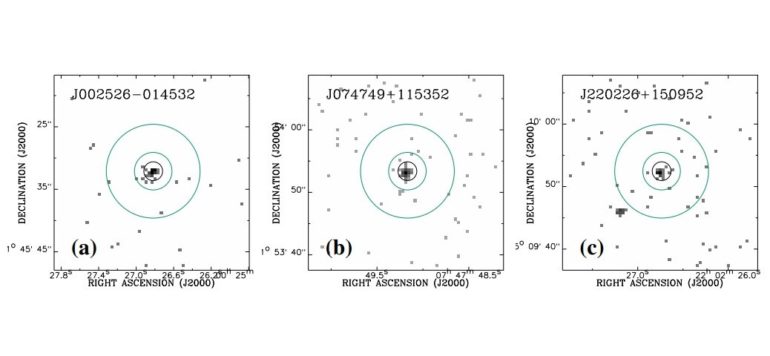Using NASA’s Chandra spacecraft, astronomers have discovered three new ultraviolet-bright radio-quiet quasars at high redshift and measured their basic X-ray properties. The newly found quasi-stellar object turns out to be the brightest in UV among the known high-redshift radio-quiet quasars. The finding is presented in a paper published November 2 on arXiv.org.
Quasars, or quasi-stellar objects (QSOs), are extremely luminous active galactic nuclei (AGN) containing supermassive central black holes with accretion disks. Their redshifts are measured from the strong spectral lines that dominate their visible and ultraviolet spectra.
Astronomers are especially interested in finding new high-redshift quasars (at redshift higher than 5.0) as they are the most luminous and most distant compact objects in the observable universe. Spectra of such QSOs can be used to estimate the mass of supermassive black holes that constrain the evolution and formation models of quasars. Therefore, high-redshift quasars could serve as a powerful tool to probe the early universe.
Recently, a team of astronomers led by Jiang-Tao Li of the University of Michigan, has used Chandra to conduct follow-up observations of very luminous radio quiet quasars. They found that three of them, designated J002526-014532, J074749+115352 and J220226+150952, are the UV brightest radio quiet ones detected at a redshift over 5.0.
“In this paper, we present new Chandra observations of three UV bright quasars at z > 5,” the astronomers wrote in the paper.
The three quasars reported in the study have a rest frame 2-10 keV luminosity of over 1 quattuordecillion erg/s and the X-ray power law photon index well constrained – in the range of 1.6 to 2.1. At a redshift of 5.26, J074749+115352 turned out to be the X-ray brightest radio-quiet high-redshift quasar, with an average observed X-ray flux at a level of 0.0349 picoergs/s/cm2.
According to the study, the high X-ray flux of J074749+115352 makes it unique for timing analysis on a timescale of a few hours at such high redshift. The astronomers noted that there are two states in the X-ray variation of this quasar: a “high soft” state with an average X-ray flux of about 2.7 times greater than that of the “low hard” state. The mass of this quasar’s supermassive black hole was estimated to be about 1.82 billion solar masses.
By comparing the newfound three quasars to other high-redshift objects of this type, the researchers underlined how much unique is J074749+115352.
“We find that J074749+115352 is extraordinarily X-ray bright, with an average αOX = −1.46 ± 0.02 and 2-10 keV bolometric correction factor Lbol/L2−10keV = 42.4 ± 5.8; both significantly depart from some well defined scaling relations. This quasar also has a high Eddington ratio of λEdd = 2.25 ± 0.09,” the authors of the paper explained.
However, they added that more X-ray and infrared observations are needed to confirm the nature and better understand the properties of this QSO.
Astronomers discover the most X-ray luminous high-redshift quasar
More information:
Li et al., Chandra Detection of Three X-ray Bright Quasars at z > 5, arXiv:2011.02358 [astro-ph.HE] arxiv.org/abs/2011.02358
Provided by
Science X Network
2020 Science X Network
Citation:
Three high-redshift quasars detected by Chandra (2020, November 12)
retrieved 12 November 2020
from https://phys.org/news/2020-11-high-redshift-quasars-chandra.html
This document is subject to copyright. Apart from any fair dealing for the purpose of private study or research, no
part may be reproduced without the written permission. The content is provided for information purposes only.



